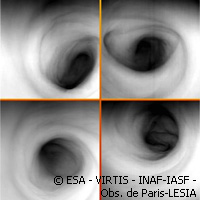Weather not set to improve on Venus, scientists say
Venus is known for its unpleasant climate and it seems that things are set to stay that way for the foreseeable future, according to new research from an international team of scientists from Belgium, Germany and the United States published in the journal Icarus. On its surface, Venus sizzles at over 800 degrees Fahrenheit under a suffocating blanket of sulfuric acid clouds and a crushing atmosphere more than 90 times the pressure of Earth's. And the team of scientists has found that this trend is set to continue. One of the study authors, Dr Tim Livengood from the National Center for Earth and Space Science Education, Capitol Heights, in the United States, contextualises Venus' particular climate: 'Any variability in the weather on Venus is noteworthy, because the planet has so many features to keep atmospheric conditions the same. Earth has seasons because its rotation axis is tilted by about 23 degrees, which changes the intensity of sunlight and the length of the day in each hemisphere throughout the year. However, Venus has been tilted so much, it's almost completely upside down, leaving it with a net tilt of less than three degrees from the sun, so the seasonal effect is negligible.' Dr Livengood continues: '[Venus'] orbit is even more circular than Earth's, which prevents it from getting significantly hotter or cooler by moving closer to or further away from the sun. And while you might expect things to cool down at night - especially since Venus rotates so slowly that its night lasts almost two Earth months - the thick atmosphere and sulfuric acid clouds act like a blanket while winds move heat around, keeping temperatures pretty even. Finally, almost all the planet's water has escaped to space, so you don't get any storms or precipitation like on Earth where water evaporates and condenses as clouds.' To carry out their study into Venus' weather patterns the team measured temperature and wind speeds in its upper atmosphere by observing an infrared glow emitted by carbon dioxide (CO2) molecules when they were energised by light from the sun. Infrared light is invisible to the human eye and is perceived by us as heat, but it can be detected by special instruments. In the research, it appeared as a line on a graph from a spectrometer, an instrument that separates light into its component colours, each of which corresponds to a specific frequency. The width of the line revealed the temperature, while shifts in its frequency gave the wind speed. The team compared observations from 1990 and 1991 to observations made in 2009. And by making comparisons with old NASA data the team also detected some bizarre things going on high above the planet's surface, in cold, clear air above the acid clouds in two layers called the mesosphere and the thermosphere. 'Although the air over the polar regions in these upper atmospheric layers on Venus was colder than the air over the equator in most measurements, occasionally it appeared to be warmer,' says another study author, Dr Theodor Kostiuk from NASA Goddard. 'In Earth's atmosphere, a circulation pattern called a 'Hadley cell' occurs when warm air rises over the equator and flows toward the poles, where it cools and sinks. Since the atmosphere is denser closer to the surface, the descending air gets compressed and warms the upper atmosphere over Earth's poles. We saw the opposite on Venus. In addition, although the surface temperature is fairly even, we've seen substantial changes - up to 54 degrees Fahrenheit (about 30 K change) - within a few Earth days in the mesosphere - thermosphere layers over low latitudes on Venus. The poles appeared to be more stable, but we still saw changes up to 27 degrees Fahrenheit (about 15 K change).' Lead author Dr Guido Sonnabend from the University of Cologne, Germany, also comments: 'The mesosphere and thermosphere of Venus are dynamically active. Wind patterns resulting from solar heating and east to west zonal winds compete, possibly resulting in altered local temperatures and their variability over time.' Venus is often described as Earth's twin due to their similar size, but we can now certainly conclude that the similarities end there and that the two planets certainly don't share the same weather patterns.For more information, please visit:European Space Agency:http://www.esa.int/esaCP/index.html
Countries
Belgium, Germany, United States



